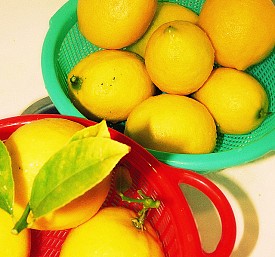Getting to Know Enzymatic Cleaners
 If you've been hunting for ecologically-friendly cleaning options, chances are high that you've encountered enzymatic cleaners, which lift dirt, grime, and odors without introducing harmful chemicals into the equation. Are you curious about how they work, where you can use them, and whether you can make your own? We've got answers to all three of those questions!
If you've been hunting for ecologically-friendly cleaning options, chances are high that you've encountered enzymatic cleaners, which lift dirt, grime, and odors without introducing harmful chemicals into the equation. Are you curious about how they work, where you can use them, and whether you can make your own? We've got answers to all three of those questions!
How they work
Enzymatic cleaners utilize proteins known as enzymes produced by living organisms like fruit and animals. The enzymes bond to specific molecules found in fats, proteins, and sugars to break them down, making it much easier to remove stains and clean up messes; and in some cases, enzymes will actually break up the chains of molecules that creature unpleasant odors, like those found in pet messes and well-worn shoes.
It's important to be aware that you need to match the enzyme to the job, because they aren't a universal binding and cleaning agent. Think of the cleaner like a key (which it essentially is) searching for a lock to fit in. Just as your post office box key won't open your front door, an enzymatic cleaner designed for one purpose can't be used for another because it won't find the right molecules to attach to. That's one reason why cleaning with enzymes can require maintaining a library of cleaning solutions for different purposes.
Where you can use them
In a range of places! These cleaners work well on soft surfaces like rugs, carpets, fabrics, upholstery, and more, where they can be used to treat oil, grease, and biological stains like blood or urine. Make sure to follow directions carefully; while the enzymes will lift the mess, you need to blot carefully to clean up, rather than rubbing in, which can make the problem worse.
Cleaners designed for wood (great for the kitchen, where you might want to clean cutting boards), leather (stinky shoes ahoy!), plastics (have a funky neoprene wetsuit?), and other materials are also available, including products designed for tubs, spas, and showers. Likewise, you can use enzymatic cleaners to clean and open drains or clean up after that unfortunate Orlando plumbing accident. The general rule of thumb is that if you can get a surface dirty, there's an enzymatic cleaner you can find to clean it up.
Can you make your own?
Yes! It will take you a bit of time, though. You can produce a basic citrus enzyme cleaner by fermenting citrus rinds for three months; as they ferment, they will produce yeasts, which will generate enzymes. Jill at One Good Thing has an excellent tutorial on producing enzyme cleaner and using the leftover material as well to create a powerful household scrub.
As with other fermented projects, you may need some trial and error to get this one right, including storing it in the right conditions and sometimes adding yeast, if the fermentation appears to be going poorly. It's also important to remember that citrus enzymes aren't universal cleaners, so this product will only work on some household stains!
While enzymatic cleaners won't replace all your cleaning needs, they can be a great choice for a non-toxic, all-natural cleaning tool that's especially useful for instant odor relief. When used in combination with other eco-friendly cleaning practices and attentive maintenance, they can keep your home looking and smelling fresh.
Katie Marks writes for Networx.com.
Looking for a Pro? Call us (866) 441-6648



